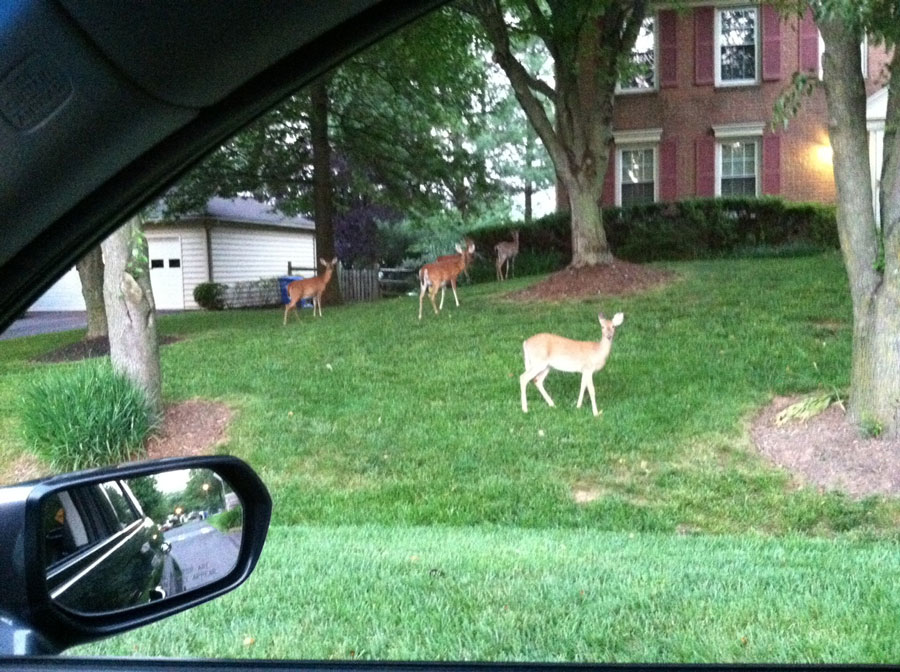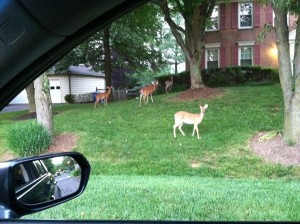
Deer Mating Season: Drive Safely (Photos)
 It’s deer mating season also known as the “rut.” That means drivers should keep a watchful eye for deer at dusk and dawn when they are most amorous. Frisky, white-tailed deer will go to any length to mate, and that includes right into the path of your vehicle, AAA Mid-Atlantic warns. Deer-vehicle crashes can be costly and deadly, the auto club advises. In addition to white-tailed deer, motorists need to keep their eyes peeled for other animals, such as bears, roaming into the roadway without warning.
It’s deer mating season also known as the “rut.” That means drivers should keep a watchful eye for deer at dusk and dawn when they are most amorous. Frisky, white-tailed deer will go to any length to mate, and that includes right into the path of your vehicle, AAA Mid-Atlantic warns. Deer-vehicle crashes can be costly and deadly, the auto club advises. In addition to white-tailed deer, motorists need to keep their eyes peeled for other animals, such as bears, roaming into the roadway without warning.
Approximately 1.6 million deer-motor vehicle crashes occur each year on roads nationwide, resulting in approximately 200 fatalities, tens of thousands of injuries and over $3.6 billion in vehicle damage, according to the Insurance Institute for Highway Safety (IIHS).
In Maryland, there were 1,587 animal-involved crashes on average yearly during the five-year period from 2007 to 2011, according to the latest data available from the Maryland Motor Vehicle Administration’s Highway Safety Office. On average, 1,355 crashes resulted in property damage. Animal-involved crashes resulted in 269 injured persons and one fatality on average.
In Maryland, AAA Insurance reported a 2.8 percent increase in the number of animal collision claims filed by their insured motorists between 2010 and the end of 2012. During that time the average cost of a claim was approximately $1,980. In Maryland, the auto club reports that the most animal collision claims filed were from the counties of Carroll, Baltimore, Frederick, Montgomery, and Harford.
“Motorists need to be extra vigilant no matter what road they travel, but especially on rural, wooded roads and during commuting times which coincide with high times of deer activity. If a deer-vehicle collision is unavoidable, don’t swerve out of your lane or lose control of your vehicle.” said Ragina C. Averella, Manager of Public and Government Affairs for AAA Mid-Atlantic. “Also protect yourself by always wearing a seat belt and staying alert and sober.”
So why did the deer cross the road? It literally boils down to biology. No matter how mild the temperatures are outside this fall, deer across our area are in heat right now. They are roaming the woods and area roadways to mate. Experts remind us, to try not to suddenly swerve to avoid hitting a deer. A collision into oncoming traffic could be even worse. Yearlings or young bucks are on their own looking for their own territory, as their mothers, who gave birth to them last year, are mating again. So deer are abundant this time of year and “they can sprint up to 35 miles per hour and are able to leap over 8 foot tall barriers,” warns the Maryland Department of Natural Resources.
AAA Tips for Drivers During Deer Mating Season
Scan the road and shoulders ahead of you. Looking ahead helps provide enough reaction time if an animal is spotted. Also, remember some animals move in groups, so when there is one, there are usually more in the area.
Use high beam headlights if there’s no oncoming traffic. Wildlife may be spotted sooner when using high beams. This will give the driver time to slow down, move over or honk the horn to scare the animal away. High beams also help in spotting some animals’ reflective eyes.
If a collision is unavoidable, apply the brakes firmly and remain in your lane. Swerving to avoid an animal can often cause a more serious crash or result in drivers losing control of vehicles.
Be extra cautious at dawn and dusk. Most animals, especially deer, tend to be more active early in the morning and at dusk.
Slow down and use extra caution when traveling through areas with a high and active wildlife population. Be aware of increased wildlife movement in some regions during certain times of year such as hunting or mating season.
Drivers should always wear a seat belt and remain awake, alert and sober.
Do not try to move the animal. An injured animal might panic and seriously injure someone. Call police or animal control for assistance.
AAA Mid-Atlantic also advises motorists to make sure their auto insurance policy covers animal strikes:
Collision vs. Comprehensive Auto Insurance Coverage
Covers damage to your car as a result of hitting or being hit by another vehicle, or object such as a light post. Collision coverage will not cover an auto-deer or other animal collision.
Comprehensive coverage – Covers damage to your vehicle resulting from incidents other than collision, such as theft or damage from flood, fire or animals. Only comprehensive coverage will reimburse drivers for loss due to contact with animals, such as deer.
If you hit an animal, contact your insurance company as soon as possible. Take photos to document the accident.

Engage us on Facebook
Follow us on Twitter
Tweets by @mymcmedia